
Sarcoscypha is a genus of ascomycete fungus and a type genus of the family Sarcoscyphaceae. Species of Sarcoscypha are present in Europe, North America and tropical Asia. They are characterised by a cup-shaped apothecium which is often brightly coloured. They have had a range of popular uses, one of which was as a table decoration. Some members of the family such as S. coccinea and the - according to new knowledge - more common S. austriaca in western Europe and United States have bright scarlet apothecia which have given them familiar names such as the scarlet cup fungus and scarlet elf cap.
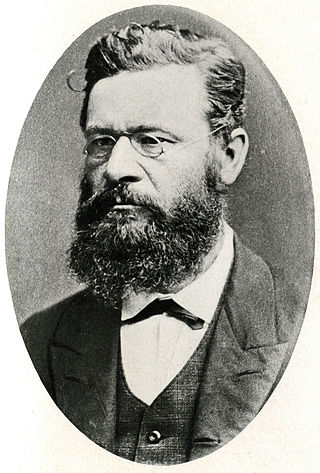
Petter Adolf Karsten was a Finnish mycologist, the foremost expert on the fungi of Finland in his day, and known in consequence as the "father of Finnish mycology".
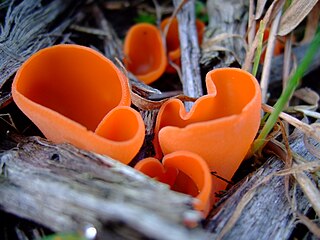
The Pezizales are an order of the subphylum Pezizomycotina within the phylum Ascomycota. The order contains 16 families, 199 genera, and 1683 species. It contains a number of species of economic importance, such as morels, the black and white truffles, and the desert truffles. The Pezizales can be saprobic, mycorrhizal, or parasitic on plants. Species grow on soil, wood, leaves and dung. Soil-inhabiting species often fruit in habitats with a high pH and low content of organic matter, including disturbed ground. Most species occur in temperate regions or at high elevation. Several members of the Sarcoscyphaceae and Sarcosomataceae are common in tropical regions.
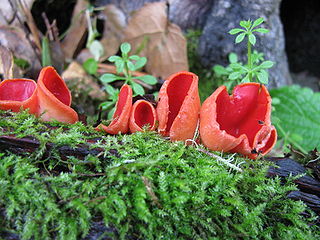
Sarcoscypha coccinea, commonly known as the scarlet elf cup, scarlet elf cap, or the scarlet cup, is a species of fungus in the family Sarcoscyphaceae of the order Pezizales. The fungus, widely distributed in the Northern Hemisphere, has been found in Africa, Asia, Europe, North and South America, and Australia. The type species of the genus Sarcoscypha, S. coccinea has been known by many names since its first appearance in the scientific literature in 1772. Phylogenetic analysis shows the species to be most closely related to other Sarcoscypha species that contain numerous small oil droplets in their spores, such as the North Atlantic island species S. macaronesica. Due to similar physical appearances and sometimes overlapping distributions, S. coccinea has often been confused with S. occidentalis, S. austriaca, and S. dudleyi.

The Pyronemataceae are a family of fungi in the order Pezizales. It is the largest family of the Pezizales, encompassing 75 genera and approximately 500 species. Phylogenetic analyses does not support the prior classifications of this family, and suggest that the family is not monophyletic as it is currently circumscribed.

The Sarcoscyphaceae are a family of cup fungi in the order Pezizales. Members of the Sarcoscyphaceae are cosmopolitan in distribution, found in both tropical and temperate regions.
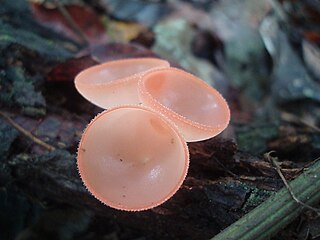
Cookeina is a genus of cup fungi in the family Sarcoscyphaceae, members of which may be found in tropical and subtropical regions of the world. Species may be found on fallen branches of angiosperms, trunks, and sometimes on fruits. The Temuans of Peninsular Malaysia are reported to use certain species from this genus as food, and also as a bait for fishing, where it is rubbed against the hook.

Chorioactis is a genus of fungi that contains the single species Chorioactis geaster. The mushroom is commonly known as the devil's cigar or the Texas star in the United States, while in Japan it is called kirinomitake (キリノミタケ). This extremely rare mushroom is notable for its unusual appearance and disjunct distribution; it is found only in select locales in Texas and Japan. The fruit body, which grows on the stumps or dead roots of cedar elms or dead oaks, somewhat resembles a dark brown or black cigar before it splits open radially into a starlike arrangement of four to seven leathery rays. The interior surface of the fruit body bears the spore-bearing tissue known as the hymenium, and is colored white to brown, depending on its age. The fruit body opening can be accompanied by a distinct hissing sound and the release of a smoky cloud of spores.

Urnula is a genus of cup fungi in the family Sarcosomataceae, circumscribed by Elias Magnus Fries in 1849. The genus contains several species found in Asia, Europe, Greenland, and North America. Sarcosomataceae fungi produce dark-colored, shallow to deep funnel-shaped fruitbodies with or without a stipe, growing in spring. The type species of the genus is Urnula craterium, commonly known as the devil's urn or the gray urn. Urnula species can grow as saprobes or parasites having an anamorphic state. The anamorphic form of U. craterium causes Strumella canker, on oak trees.
Korfiella is a fungal genus in the family Sarcosomataceae. A monotypic genus, it contains the single species Korfiella karnika, found in India and described as new to science in 1970.

Plectania is a genus of fungi in the family Sarcosomataceae. It was circumscribed by German botanist Karl Wilhelm Gottlieb Leopold Fuckel in 1870.

Microstoma floccosum is a species in the cup fungus family Sarcoscyphaceae. It is recognizable by its deep funnel-shaped, scarlet-colored fruit bodies bearing white hairs on the exterior. Found in the United States and Asia, it grows on partially buried sticks and twigs of oak trees.

Wynnea is a genus of fungi in the family Sarcoscyphaceae. Circumscribed by Miles Joseph Berkeley and Moses Ashley Curtis in 1867, the genus contains seven species that have ear-shaped fruit bodies that grow on the ground. Wynnea species have a worldwide distribution and have been collected from the United States, Costa Rica, India, and China.

Wynnea americana, commonly known as moose antlers or rabbit ears, is a species of fungus in the family Sarcoscyphaceae. This uncommon inedible species is recognizable by its spoon-shaped or rabbit-ear shaped fruit bodies that may reach up to 13 cm (5.1 in) tall. It has dark brown and warty outer surfaces, while the fertile spore-bearing inner surface is orange to pinkish to reddish brown. The fruit bodies grow clustered together from large underground masses of compacted mycelia known as sclerotia. In eastern North America, where it is typically found growing in the soil underneath hardwood trees, it is found from New York to Michigan south to Mexico. The species has also been collected from Costa Rica, India, and Japan.
Desmazierella is a genus of fungi in the family Sarcoscyphaceae. The genus was circumscribed in 1829 by Belgian mycologist Marie-Anne Libert in Ann. Sci. Nat. Paris Vol.17 on page 82 in 1829 with the type, D. acicola, as the sole species.
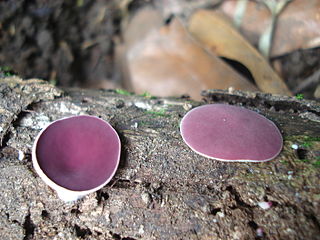
Phillipsia is a genus of fungi in the family Sarcoscyphaceae. There are about 17 species in the genus, which collectively have a widespread distribution in subtropical and tropical areas. The genus was circumscribed by Miles Joseph Berkeley in 1881. The generic name honours Wales-born English botanist William Phillips (1822–1905).
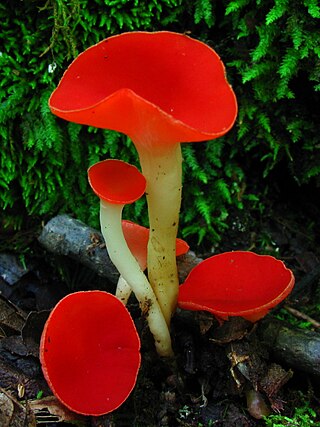
Sarcoscypha occidentalis, commonly known as the stalked scarlet cup or the western scarlet cup, is a species of fungus in the family Sarcoscyphaceae of the Pezizales order. Fruit bodies have small, bright red cups up to 2 cm (0.8 in) wide atop a slender whitish stem that is between 1 and 3 cm long. A saprobic species, it is found growing on hardwood twigs, particularly those that are partially buried in moist and shaded humus-rich soil. The fungus is distributed in the continental United States east of the Rocky Mountains, Central America, the Caribbean, and Asia. It is distinguished from the related species S. coccinea and S. austriaca by differences in geographical distribution, fruiting season, and fruit body structure. Phylogenetic analysis has shown that it is most closely related to other Sarcoscypha species that contain large oil droplets in their spores. The species Molliardiomyces occidentalis is an imperfect form of the fungus that lacks a sexually reproductive stage in its life cycle.

Sarcoscypha dudleyi, commonly known as the crimson cup or the scarlet cup, is a species of fungus in the family Sarcoscyphaceae of the order Pezizales. In addition to its main distribution in the central to eastern United States, the fungus has also been recorded once in Bulgaria. It has been frequently confused with Sarcoscypha coccinea, but can be distinguished from this and other related species in Sarcoscypha by differences in microscopic characteristics, such as the presence and number of oil droplets in the spores. The species Molliardiomyces dudleyi is an imperfect form of the fungus that lacks a sexually reproductive stage in its life cycle.
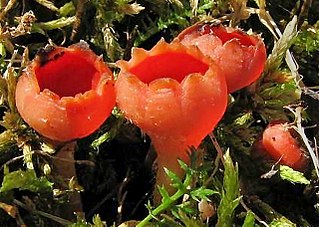
Microstoma protractum is a species of cup fungus in the family Sarcoscyphaceae. It was first described as a species of Peziza by Elias Magnus Fries in 1851. American mycologist Bessie B. Kanouse assigned it its current name in 1948. The fungus is found in Europe and North America, where it grows as a saprophyte on partially buried sticks and roots.

Phillipsia subpurpurea is a species of fungus in the family Sarcoscyphaceae. It is found in Australia where it grows as a saprophyte on wood. The fungus was first described scientifically by English mycologists Miles Joseph Berkeley and Christopher Edmund Broome. Its cup-shaped fruit bodies lack stipes and have purplish interior surfaces.

















